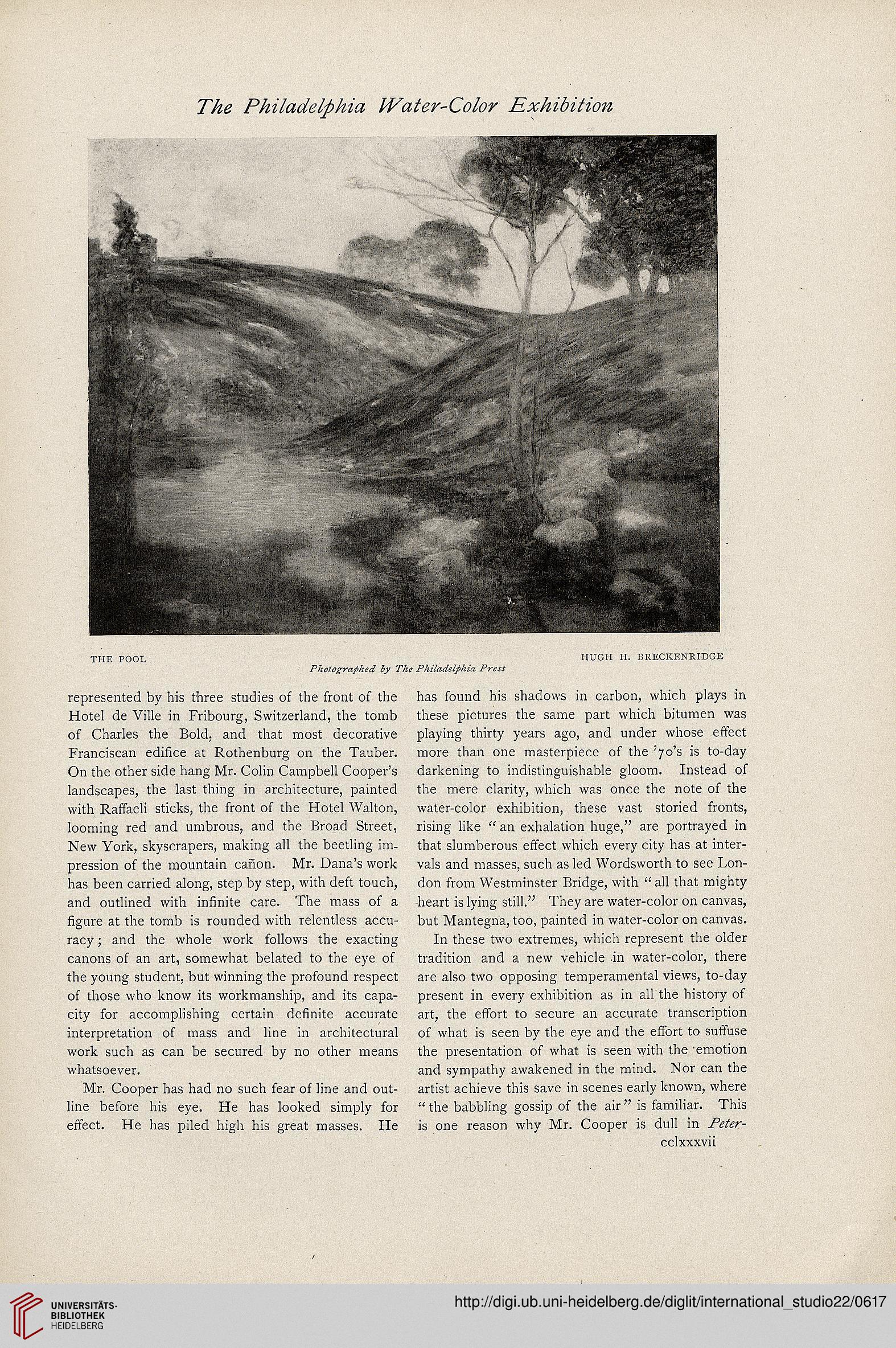71%<? 77w%f7y727%
THE POOL
HUGH H. BRECKEXRIDGE
represented by his three studies of the front of the
Hotef de Viiie in Fribourg, Switzerland, the tomb
of Charles the Bold, and that most decorative
Franciscan edifice at Rothenburg on the Tauber.
On the other side hang Mr. Colin Campbell Cooper's
landscapes, the last thing in architecture, painted
with Raffaeli sticks, the front of the Hotel Walton,
looming red and umbrous, and the Broad Street,
New York, skyscrapers, making all the beetling im-
pression of the mountain canon. Mr. Dana's work
has been carried along, step by step, with deft touch,
and outlined with infinite care. The mass of a
figure at the tomb is rounded with relentless accu-
racy ; and the whole work follows the exacting
canons of an art, somewhat belated to the eye of
the young student, but winning the profound respect
of those who know its workmanship, and its capa-
city for accomplishing certain definite accurate
interpretation of mass and line in architectural
work such as can be secured by no other means
whatsoever.
Mr. Cooper has had no such fear of line and out-
line before his eye. He has looked simply for
effect. He has piled high his great masses. He
has found his shadows in carbon, which plays in
these pictures the same part which bitumen was
playing thirty years ago, and under whose effect
more than one masterpiece of the 'yo's is to-day
darkening to indistinguishable gloom. Instead of
the mere clarity, which was once the note of the
water-color exhibition, these vast storied fronts,
rising like " an exhalation huge," are portrayed in
that slumberous effect which every city has at inter-
vals and masses, such as led Wordsworth to see Lon-
don from Westminster Bridge, with "all that mighty
heart is lying still." They are water-color on canvas,
but Mantegna, too, painted in water-color on canvas.
In these two extremes, which represent the older
tradition and a new vehicle in water-color, there
are also two opposing temperamental views, to-day
present in every exhibition as in all the history of
art, the effort to secure an accurate transcription
of what is seen by the eye and the effort to suffuse
the presentation of what is seen with the emotion
and sympathy awakened in the mind. Nor can the
artist achieve this save in scenes early known, where
"the babbling gossip of the air" is familiar. This
is one reason why Mr. Cooper is dull in
cclxxxvii
THE POOL
HUGH H. BRECKEXRIDGE
represented by his three studies of the front of the
Hotef de Viiie in Fribourg, Switzerland, the tomb
of Charles the Bold, and that most decorative
Franciscan edifice at Rothenburg on the Tauber.
On the other side hang Mr. Colin Campbell Cooper's
landscapes, the last thing in architecture, painted
with Raffaeli sticks, the front of the Hotel Walton,
looming red and umbrous, and the Broad Street,
New York, skyscrapers, making all the beetling im-
pression of the mountain canon. Mr. Dana's work
has been carried along, step by step, with deft touch,
and outlined with infinite care. The mass of a
figure at the tomb is rounded with relentless accu-
racy ; and the whole work follows the exacting
canons of an art, somewhat belated to the eye of
the young student, but winning the profound respect
of those who know its workmanship, and its capa-
city for accomplishing certain definite accurate
interpretation of mass and line in architectural
work such as can be secured by no other means
whatsoever.
Mr. Cooper has had no such fear of line and out-
line before his eye. He has looked simply for
effect. He has piled high his great masses. He
has found his shadows in carbon, which plays in
these pictures the same part which bitumen was
playing thirty years ago, and under whose effect
more than one masterpiece of the 'yo's is to-day
darkening to indistinguishable gloom. Instead of
the mere clarity, which was once the note of the
water-color exhibition, these vast storied fronts,
rising like " an exhalation huge," are portrayed in
that slumberous effect which every city has at inter-
vals and masses, such as led Wordsworth to see Lon-
don from Westminster Bridge, with "all that mighty
heart is lying still." They are water-color on canvas,
but Mantegna, too, painted in water-color on canvas.
In these two extremes, which represent the older
tradition and a new vehicle in water-color, there
are also two opposing temperamental views, to-day
present in every exhibition as in all the history of
art, the effort to secure an accurate transcription
of what is seen by the eye and the effort to suffuse
the presentation of what is seen with the emotion
and sympathy awakened in the mind. Nor can the
artist achieve this save in scenes early known, where
"the babbling gossip of the air" is familiar. This
is one reason why Mr. Cooper is dull in
cclxxxvii




